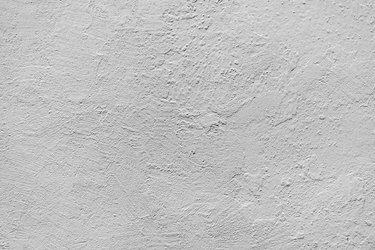If you currently have a stucco roof or walls on your home but wish to do more to prevent water from penetrating the surface, the installation of metal flashing can go a long way. Typically made of aluminium or galvanized steel, flashing is any material used over joints in your walls or roof to prevent water from seeping through. You'll often find it around chimneys, vents or windows. Flashing is fairly easy to install. Before you begin installing stucco flashing, however, you'll want to familiarize yourself with some safety strategies.

Video of the Day
Basic Safety Tips
If the flashing you are hoping to install is located high on the walls or on the roof of your home, it's essential that you observe certain safety tips. If you'll be using a ladder, be sure that it is firmly planted. Take even more precautions and request that another person hold the base of the ladder as you climb. This helper should remain there while you're working to spot you.
Video of the Day
If it is raining or has recently rained, hold off on this sort of work, as water can cause slippery conditions. In addition, don't undertake flashing installation, or any kind of outdoor work, during a thunderstorm.
Considerations Before You Work
If you'll be adding flashing or replacing existing flashing on your roof, first remove any shingles that will be in the place you hope to add the new metal material. Since you're covering stucco, there may not be shingles to remove. Some professionals advise cutting out chunks of stucco, adding the flashing and then replacing the stucco in the area. However, this can mean that you won't have a uniform look, and it isn't always effective. You can also simply add the flashing onto the existing stucco and then stucco around it. This may work as a stucco sealer if done properly.
Metal flashing can be purchased in a variety of sizes and shapes. Take a look at the area you wish to cover with flashing and use it to inform your purchasing decision. You will also need roofing felt, asphalt cement, caulk, nails and a hammer.
Stucco Roof Flashing Installation
If you'll be working on the roof, use roofing felt to cover the area where you'll be adding flashing. Be sure to overlap the old felt with the new felt by a foot, and secure it with nails. Then, add a layer of asphalt cement to the area where you will attach the flashing. Before the cement is given too much time to dry, lay the flashing down and press it firmly into the cement. Use a few nails to secure it in place. You may need to use a drill and screws instead of nails, depending on how easy it is to get through the existing stucco.
If you'll be installing step flashing, in which one piece of flashing is placed over the first in a staggered way, apply additional cement and the next piece of flashing. Attach it to the roof in the same way. When you have finished installing the flashing, use either caulk or additional stucco to seal around the edges and prevent water infiltration to the roof.